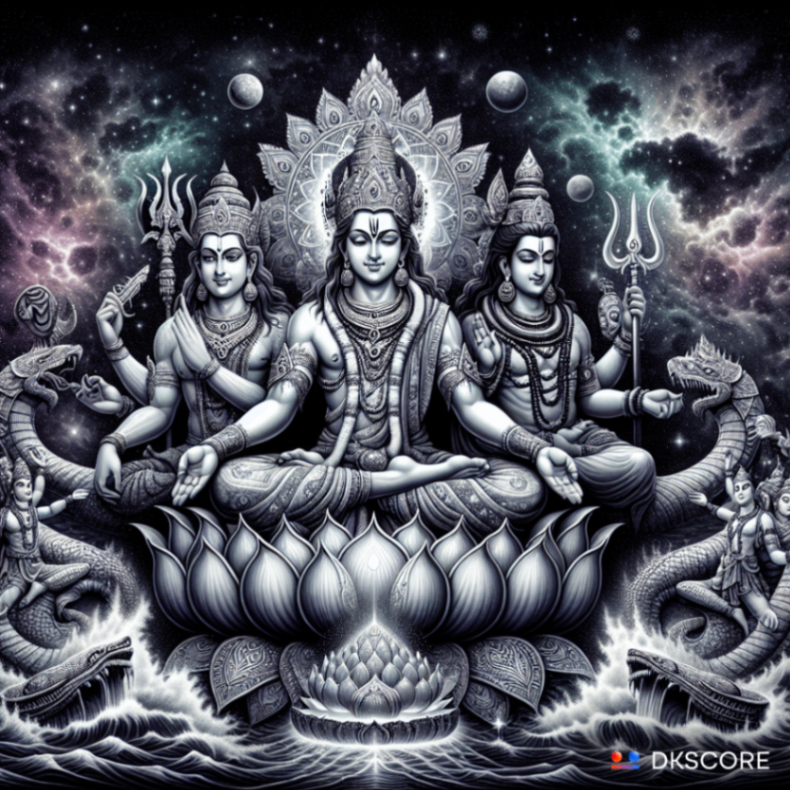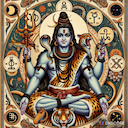In Vedic astrology and Hindu cosmology, the trinity of Brahma Vishnu and Shiva represents the fundamental aspects of existence. This trinity, also known as the Trimurti, embodies the processes of creation, preservation, and destruction, respectively. Understanding these three deities provides deep insights into the cosmic order and the cycle of life.
The Concept of Trimurti: The Principal Deities
The concept of Trimurti signifies the unity of three principal deities who perform cosmic functions of creation, preservation, and destruction. These functions are essential for the universes continuous evolution and balance.
Brahma: The Creator

Brahma, the creator, is responsible for the genesis of the universe. He symbolizes the creative force that brings forth all life and matter. According to Vedic texts, Brahma emerged from a lotus that sprouted from the navel of Lord Vishnu, signifying the interconnectedness of creation and preservation.
How Brahma Vishnu Mahesh Were Born
Understanding how they were born delves into the mysteries of cosmic origins. Brahmas birth from Vishnus navel illustrates the seamless flow of creation from preservation.
Vishnu: The Preserver

Vishnu, the preserver, maintains the order and harmony of the cosmos. His role is crucial in sustaining life and ensuring the smooth functioning of the universe. Vishnu is often depicted resting on the serpent Ananta, floating in the cosmic ocean, from where he governs the universe.
Functions of Creation Preservation
Vishnus role highlights the functions of creation preservation, ensuring that the universe remains balanced and life continues to thrive.
Shiva (Mahesh): The Destroyer

Shiva, also known as Mahesh, is the destroyer or transformer. His role is to bring about the dissolution of the universe, making way for new creation. This cyclical process of creation, preservation, and destruction is essential for the continuous evolution of the cosmos. Shivas symbolic representation with a trishul (trident) signifies the three fundamental aspects of existence: creation, preservation, and destruction.
The Origin of the Trimurti
The concept of Brahma Vishnu Mahesh transcends the idea of three individual deities. Instead, they represent different aspects of a single divine entity. This notion aligns with the Vedic understanding that the universe is a manifestation of one supreme reality, where these three forces operate in unison.
Who Created Brahma Vishnu Mahesh?
Many wonder, who created them? According to Hindu mythology, the supreme force that precedes the Trimurti is often referred to as the Adi Purusha or the original being. Different texts offer varied perspectives on the hierarchy among the deities, but they unanimously emphasize the unity and interdependence of these forces.
Who Is Above Brahma Vishnu Mahesh?
Exploring who is above leads to the concept of the ultimate reality or Brahman, the infinite and unchanging truth behind the universe.
Brahma Vishnu Mahesh in Vedic Astrology
In Vedic astrology, the Trimurti influences various aspects of life and cosmic events. Brahmas energy is associated with the creative aspects of life, Vishnus energy governs sustenance and protection, while Shivas energy influences transformation and liberation. Astrologers often analyze planetary positions to understand the influence of these divine forces on an individuals life.
Relevance of Houses in Vedic Astrology
Understanding the houses in astrology is crucial for interpreting their influence.
Kendra Houses Represent Brahma
The Kendra houses (1st, 4th, 7th, and 10th) are associated with Brahma, symbolizing the foundational aspects of creation in a persons life. These houses represent the core areas where ones life is created and established.
Trikona Houses Represent Vishnu
The Trikona houses (5th and 9th) are associated with Vishnu, representing areas of life where growth, learning, and sustenance occur. These houses signify the nurturing and maintaining aspects that Vishnu embodies.
Upachaya Houses Represent Vishnu
The Upachaya houses (3rd, 6th, 10th, and 11th) are also associated with Vishnu, highlighting areas where effort and improvement are necessary. These houses deal with challenges and the strength required to maintain order.
Dual Signs Represent Mahesh (Shiva)
The dual signs (3rd, 6th, 9th, and 12th) are linked to Shiva. These houses are crucial in understanding the transformational aspects of ones life. When these signs are afflicted by malefic planets like Saturn, Mars, Rahu, or Ketu, it indicates that the individuals capacity to let go and transform (Maheshs influence) might be challenged. This could lead to attachments to material things, and during Maheshs periods in life, the person might face significant challenges and suffering as they struggle to release their possessions and attachments.
The Shoola Chakra in Vedic Astrology

The Shoola Chakra is a vital concept in Vedic astrology, symbolizing the trident (trishul) of Shiva. This chart highlights the three tips where specific Nakshatras (lunar mansions) are placed based on an individuals horoscope. If malefic planets transit these Nakshatras and the birth promise suggests pain or suffering due to previous or current life karmas, the transit of malefics through these Nakshatras can be highly challenging.
The Shoola Chakra underscores the potential for suffering and transformative experiences, particularly when these Nakshatras are afflicted. Understanding this aspect of the horoscope can provide profound insights into the karmic patterns and challenges an individual may face, especially during periods influenced by Mahesh (Shiva).
The Nakshatras and Their Divine Rulers
In Vedic astrology, the zodiac is divided into 27 Nakshatras or lunar mansions, each governed by specific deities. These deities often embody aspects of Brahma Vishnu Mahesh, reflecting the cosmic functions they represent.
For instance, Brahma is linked to Nakshatras like Rohini and Mrigashira, symbolizing creativity and the birth of new ideas.
Vishnu governs Nakshatras such as Shravana and Dhanishta, emphasizing preservation, learning, and harmony.
Mahesh (Shiva) is associated with Nakshatras like Ardra and Jyestha, highlighting themes of transformation, destruction of ignorance, and deep introspection.
By analyzing the Nakshatras present in an individuals birth chart, astrologers can interpret how the energies of creation, preservation, and destruction influence their lifes journey.
Planetary Deities and the Trimurti
The planets in Vedic astrology, known as the Navagrahas, are also connected to the Trimurti, each embodying specific aspects of the trimurti.
Jupiter (Guru), representing wisdom and growth, aligns with Brahmas creative force.
Mercury (Budha), governing intellect and communication, resonates with Vishnus role in maintaining order and harmony.
Mars (Mangal), symbolizing energy and courage, reflects Maheshs transformative power. Understanding these associations helps astrologers assess how planetary positions affect an individuals capacity for creation, preservation, and transformation. It provides a nuanced perspective on personal challenges and opportunities for growth.
The Role of the Dasha System
The Dasha system in Vedic astrology outlines planetary periods that influence different phases of an individuals life. These periods can be associated with the energies of trimurti depending on the ruling planet.
For example, a Venus Dasha might emphasize creation and beauty, aligning with Brahmas energy.
Saturn Dasha could bring lessons in discipline and detachment, echoing Maheshs transformative aspect.
Recognizing which deitys influence is predominant during a particular Dasha helps individuals understand the underlying cosmic forces at play, enabling them to navigate life more consciously.
Aligning with the Trimurti Through Remedies
Vedic astrology also offers remedies to harmonize the influences of trimurti in ones life.
Practices such as chanting specific mantras, performing rituals, or wearing gemstones can enhance positive energies and mitigate challenges.
For instance, reciting the Maha Mrityunjaya Mantra invokes Maheshs grace for transformation and healing.
Worshipping Vishnu through the Om Namo Bhagavate Vasudevaya mantra can promote preservation and protection.
Honoring Brahma by engaging in creative endeavors or studying sacred texts fosters the creative impulse.
These remedies help individuals align more closely with the cosmic functions of creation, preservation, and destruction, leading to a more balanced and fulfilling life.
What Classic Texts Say About Brahma Vishnu Mahesh
Classic Vedic texts offer deep insights into the significance of the Trimurti.
References in the Vedas
The Vedas, among the oldest sacred texts, refer to the three cosmic functions performed by the Trimurti. They emphasize the importance of these deities in maintaining the balance of the universe.
The Puranas and the Trimurti
The Puranas provide detailed stories and explanations about them. They narrate the origins, deeds, and relationships between these deities, highlighting their roles in cosmic events.
The Bhagavad Gitas Perspective
In the Bhagavad Gita, Lord Krishna, an avatar of Vishnu, explains the nature of reality and the importance of performing ones duty. The text underscores the interconnectedness of creation, preservation, and destruction.
Symbolism and Cultural Significance
The symbolism is deeply embedded in Hindu culture and spirituality. Temples, rituals, and festivals dedicated to these deities highlight their importance in maintaining cosmic balance. The trishul of Shiva, the lotus of Brahma, and the serpent of Vishnu are powerful symbols that represent the underlying unity of the cosmos.
Brahma Vishnu Mahesh Image and Representation
Visual depictions, serve as tools for meditation and understanding. These images often portray the deities with their unique attributes, aiding devotees in connecting with their energies.
Brahma Vishnu Mahesh Meaning
The meaning is profound. They represent the perpetual cycle of birth, life, and death that all beings experience.
Brahma Vishnu Maheshs Parents
For those curious about brahma vishnu mahesh ke mata pita kaun hai (who are the parents of Brahma, Vishnu, Mahesh), its essential to understand that these deities are often considered eternal and self-born. However, in some texts, Goddess Adi Parashakti is mentioned as the supreme mother.
Significance in Personal Life
Understanding offers profound insights into personal growth and transformation.
Embracing the Cycle of Life

By recognizing the roles of creation, preservation, and destruction, individuals can better navigate lifes challenges.
Applying Vedic Astrology Insights
Applying the principles of Vedic astrology can help individuals understand their lifes path and karmic lessons.
Conclusion
Understanding Brahma Vishnu Mahesh offers profound insights into the Vedic view of the universe. These three deities are not merely mythological figures but represent the fundamental principles of creation, maintenance, and destruction. Their worship and reverence underscore the intricate balance and interdependence of all cosmic forces.
By exploring the concept of Trimurti and the cosmic functions of creation, we delve into the essence of existence. The principal deities guide us in understanding our place in the universe and how we can align with these energies for personal and spiritual growth.












